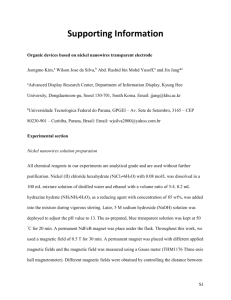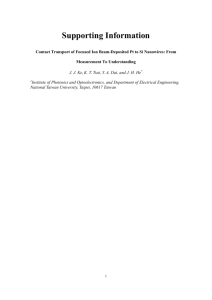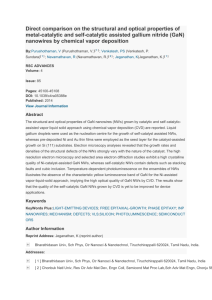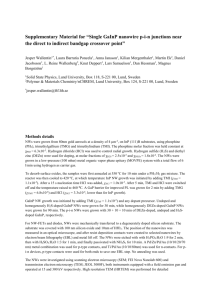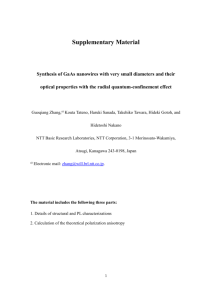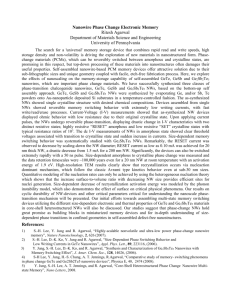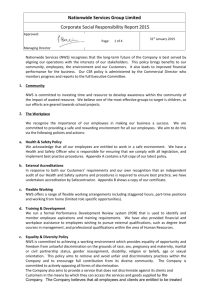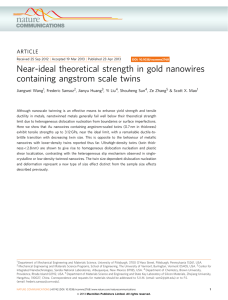3Estonian Nanotechnology Competence Centre, Riia 142, 51014
advertisement
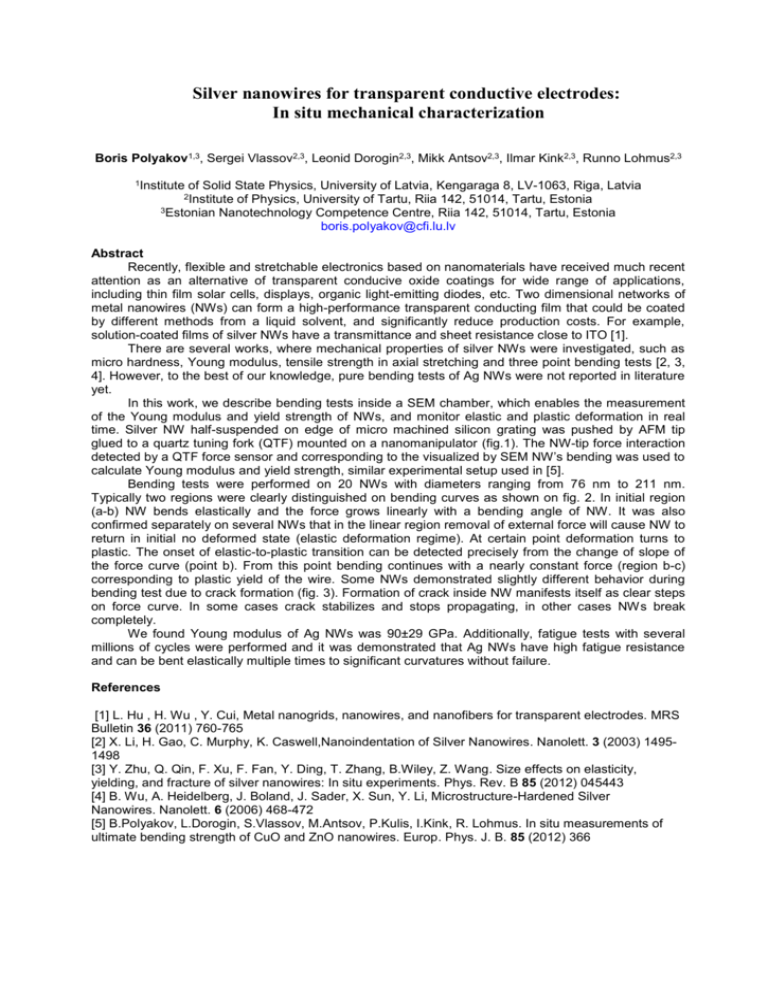
Silver nanowires for transparent conductive electrodes: In situ mechanical characterization Boris Polyakov1,3, Sergei Vlassov2,3, Leonid Dorogin2,3, Mikk Antsov2,3, Ilmar Kink2,3, Runno Lohmus2,3 1Institute of Solid State Physics, University of Latvia, Kengaraga 8, LV-1063, Riga, Latvia of Physics, University of Tartu, Riia 142, 51014, Tartu, Estonia 3Estonian Nanotechnology Competence Centre, Riia 142, 51014, Tartu, Estonia boris.polyakov@cfi.lu.lv 2Institute Abstract Recently, flexible and stretchable electronics based on nanomaterials have received much recent attention as an alternative of transparent conducive oxide coatings for wide range of applications, including thin film solar cells, displays, organic light-emitting diodes, etc. Two dimensional networks of metal nanowires (NWs) can form a high-performance transparent conducting film that could be coated by different methods from a liquid solvent, and significantly reduce production costs. For example, solution-coated films of silver NWs have a transmittance and sheet resistance close to ITO [1]. There are several works, where mechanical properties of silver NWs were investigated, such as micro hardness, Young modulus, tensile strength in axial stretching and three point bending tests [2, 3, 4]. However, to the best of our knowledge, pure bending tests of Ag NWs were not reported in literature yet. In this work, we describe bending tests inside a SEM chamber, which enables the measurement of the Young modulus and yield strength of NWs, and monitor elastic and plastic deformation in real time. Silver NW half-suspended on edge of micro machined silicon grating was pushed by AFM tip glued to a quartz tuning fork (QTF) mounted on a nanomanipulator (fig.1). The NW-tip force interaction detected by a QTF force sensor and corresponding to the visualized by SEM NW’s bending was used to calculate Young modulus and yield strength, similar experimental setup used in [5]. Bending tests were performed on 20 NWs with diameters ranging from 76 nm to 211 nm. Typically two regions were clearly distinguished on bending curves as shown on fig. 2. In initial region (a-b) NW bends elastically and the force grows linearly with a bending angle of NW. It was also confirmed separately on several NWs that in the linear region removal of external force will cause NW to return in initial no deformed state (elastic deformation regime). At certain point deformation turns to plastic. The onset of elastic-to-plastic transition can be detected precisely from the change of slope of the force curve (point b). From this point bending continues with a nearly constant force (region b-c) corresponding to plastic yield of the wire. Some NWs demonstrated slightly different behavior during bending test due to crack formation (fig. 3). Formation of crack inside NW manifests itself as clear steps on force curve. In some cases crack stabilizes and stops propagating, in other cases NWs break completely. We found Young modulus of Ag NWs was 90±29 GPa. Additionally, fatigue tests with several millions of cycles were performed and it was demonstrated that Ag NWs have high fatigue resistance and can be bent elastically multiple times to significant curvatures without failure. References [1] L. Hu , H. Wu , Y. Cui, Metal nanogrids, nanowires, and nanofibers for transparent electrodes. MRS Bulletin 36 (2011) 760-765 [2] X. Li, H. Gao, C. Murphy, K. Caswell,Nanoindentation of Silver Nanowires. Nanolett. 3 (2003) 14951498 [3] Y. Zhu, Q. Qin, F. Xu, F. Fan, Y. Ding, T. Zhang, B.Wiley, Z. Wang. Size effects on elasticity, yielding, and fracture of silver nanowires: In situ experiments. Phys. Rev. B 85 (2012) 045443 [4] B. Wu, A. Heidelberg, J. Boland, J. Sader, X. Sun, Y. Li, Microstructure-Hardened Silver Nanowires. Nanolett. 6 (2006) 468-472 [5] B.Polyakov, L.Dorogin, S.Vlassov, M.Antsov, P.Kulis, I.Kink, R. Lohmus. In situ measurements of ultimate bending strength of CuO and ZnO nanowires. Europ. Phys. J. B. 85 (2012) 366 Figures Figure 1. Schematics of experiment setup inside SEM. AFM tip glued on QTF pushes a silver NW on silicon grating. Figure 2. Bending test of Ag NW. Set of four SEM images and corresponding force registered simultaneously by force sensor. Tip approaches a NW (a). Maximal elastic deformation of NW (b). Plastic deformation regime (c). Retraction of the tip (d). Force curve of NW deformation (e). Figure 3. SEM images of plastically deformed Ag NWs. Bend without cracking (a). Cracked during bending (b).
